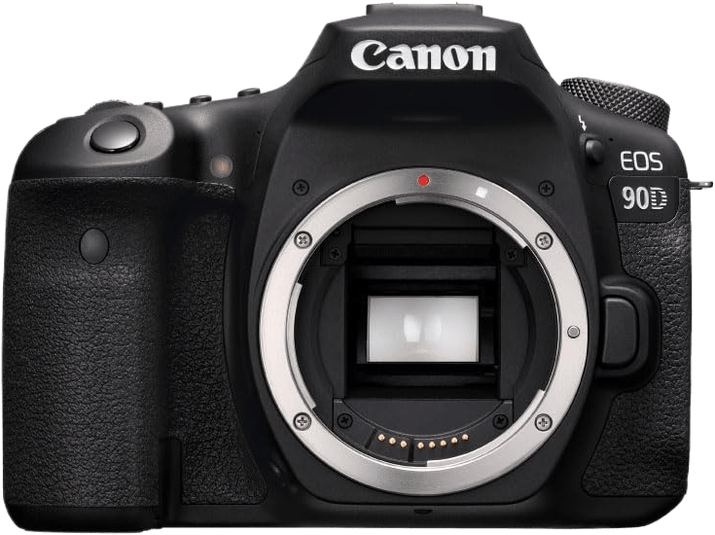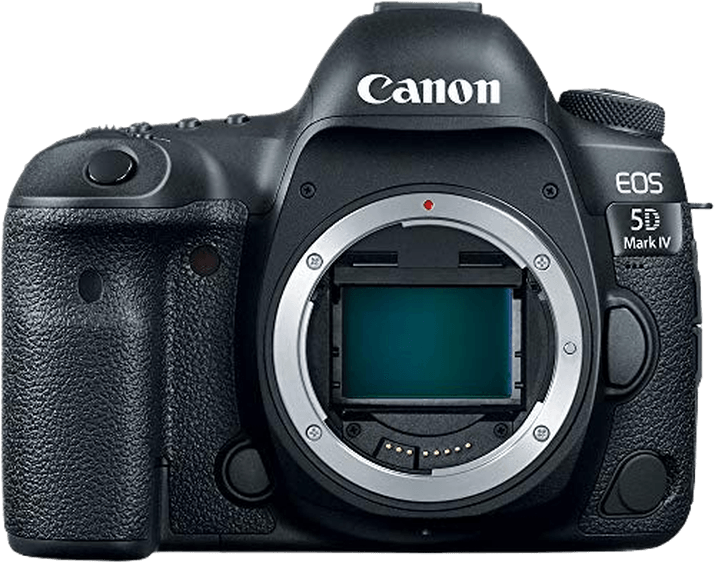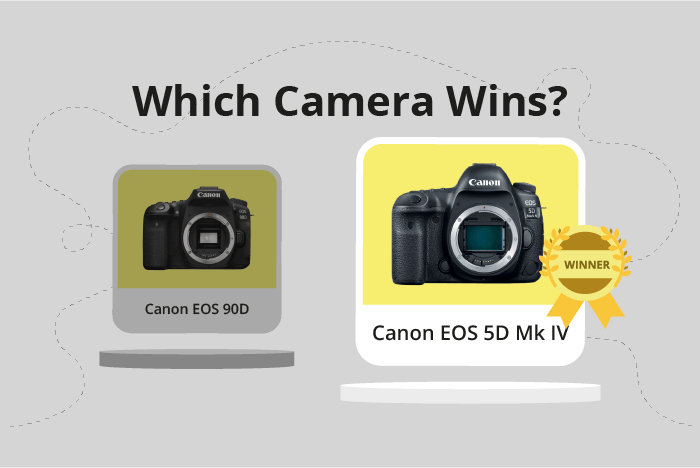Canon EOS 90D vs EOS 5D Mark IV Comparison
Canon EOS 90D

Canon EOS 5D Mark IV

The Canon EOS 5D Mark IV outperforms the Canon EOS 90D with a score of 75/100 compared to 67/100. Both cameras are DSLRs, released in 2016 and 2019 respectively. They share similar dimensions, with the 5D Mark IV being slightly larger and heavier at 151 x 116 x 76mm and 890g, while the 90D measures 141 x 105 x 77mm and weighs 701g.
The 5D Mark IV excels due to its superior overall performance, justifying its higher launch price of $3500 compared to the 90D’s $1199. On the other hand, the 90D offers a more affordable option without compromising too much on quality.
Taking these factors into account, the Canon EOS 5D Mark IV is the better choice for those seeking top-notch performance, while the Canon EOS 90D provides a budget-friendly alternative for decent photography.
Canon EOS 90D vs EOS 5D Mark IV Overview and Optics
The Canon EOS 5D Mark IV outperforms the Canon EOS 90D in optics with a score of 76/100 compared to 62/100. Both cameras share certain specifications, such as having a CMOS sensor, no image stabilization, and a Canon EF lens mount.
The 5D Mark IV has a superior sensor, with a DXOMARK score of 91 compared to the 90D’s 58. This is a significant difference, indicating that the 5D Mark IV captures better image quality. Additionally, the 5D Mark IV features a full-frame sensor, which offers better low light performance and a wider field of view compared to the 90D’s APS-C sensor. Despite having a slightly lower megapixel count of 30.4 compared to the 90D’s 33, the 5D Mark IV still produces high-resolution images.
On the other hand, the Canon EOS 90D has a faster shooting speed of 10 frames per second compared to the 5D Mark IV’s 7. This allows the 90D to capture fast-moving subjects more effectively. The 90D also has a more advanced processor, the Digic 8, which contributes to its higher shooting speed and improved autofocus performance.
Taking these factors into account, the Canon EOS 5D Mark IV is the superior camera in terms of optics, with a higher score and better sensor performance. However, the Canon EOS 90D offers advantages in shooting speed and processing power, making it a suitable choice for photographers who prioritize capturing fast action.
Canon EOS 90D vs EOS 5D Mark IV Video Performance
The Canon EOS 90D and Canon EOS 5D Mark IV both have a video score of 91/100, making them equal in video capabilities. They share several common specifications, including a maximum video resolution of 4K, a maximum video frame rate of 120fps, and built-in time-lapse functionality.
The Canon EOS 90D, however, has a maximum video dimension of 3840 x 2160, which is slightly lower than the Canon EOS 5D Mark IV’s maximum video dimension of 4096 x 2160. This difference indicates that the EOS 5D Mark IV is better in terms of video dimensions, providing a wider aspect ratio for a more cinematic look.
On the other hand, the Canon EOS 90D does not surpass the EOS 5D Mark IV in any specific aspect of video capabilities, as both cameras have the same score and share most of the same features. This implies that the EOS 90D is not better than the EOS 5D Mark IV in any significant way for video recording.
Taking these factors into account, it is clear that both cameras offer excellent video capabilities with their high scores and shared features. The Canon EOS 5D Mark IV stands out with its wider video dimensions, providing a more cinematic look. However, the Canon EOS 90D still offers the same high-quality video recording without any significant drawbacks compared to the EOS 5D Mark IV. As a result, both cameras are strong choices for users looking to capture high-quality video footage, with the EOS 5D Mark IV offering a slight edge in terms of video dimensions.
Canon EOS 90D vs EOS 5D Mark IV Features and Benefits
The Canon EOS 90D wins the features comparison with a score of 83/100, while the Canon EOS 5D Mark IV scores 74/100. Both cameras have a touchscreen, WiFi capabilities, and similar screen sizes (3 inches for the 90D and 3.2 inches for the 5D Mark IV). However, there are differences in their features that contribute to the higher score of the EOS 90D.
The EOS 90D outperforms the 5D Mark IV with its flip screen and Bluetooth capabilities. A flip screen is useful for capturing images and video from various angles, providing more versatility to the photographer. Bluetooth connectivity allows for easier and faster transfer of files, making the 90D more convenient for sharing images.
On the other hand, the 5D Mark IV has a higher screen resolution of 1,620,000 dots compared to the 1,040,000 dots of the 90D. This results in a clearer and sharper display, which is beneficial for reviewing images and focusing. Additionally, the 5D Mark IV has GPS functionality, allowing users to geotag their images and track their shooting locations.
Despite the higher screen resolution and GPS capabilities of the 5D Mark IV, the EOS 90D comes out ahead due to its flip screen and Bluetooth features. These advantages make the 90D more versatile and convenient for photographers. While the 5D Mark IV has its merits, the 90D’s superior features make it the better choice in this comparison.
Canon EOS 90D vs EOS 5D Mark IV Storage and Battery
The Canon EOS 5D Mark IV outperforms the Canon EOS 90D in storage and battery with a score of 71/100, a 23-point lead over the 90D’s score of 48/100. Both cameras use the LP-E6N battery type and do not support USB charging. However, the 5D Mark IV offers more versatility in storage options and memory card compatibility.
The 5D Mark IV has two memory card slots, accepting SD/SDHC/SDXC (UHS-I compatible) and Compact Flash cards, while the 90D has only one slot, supporting SD/SDHC/SDXC (UHS-II compatible) cards. This dual-slot design in the 5D Mark IV provides more storage capacity and the convenience of using different card types.
On the other hand, the 90D has a longer battery life, offering 1300 shots compared to the 5D Mark IV’s 900 shots. This advantage makes the 90D more suitable for extended shooting sessions without the need for frequent battery changes.
Considering these factors, the Canon EOS 5D Mark IV excels in storage flexibility, while the Canon EOS 90D offers superior battery life. Depending on individual preferences and shooting requirements, photographers can choose the camera that best suits their needs.
Alternatives to the Canon EOS 90D and EOS 5D Mark IV
Are you still undecided about which camera is right for you? Have a look at these popular comparisons that feature the Canon EOS 90D or the Canon EOS 5D Mark IV:

